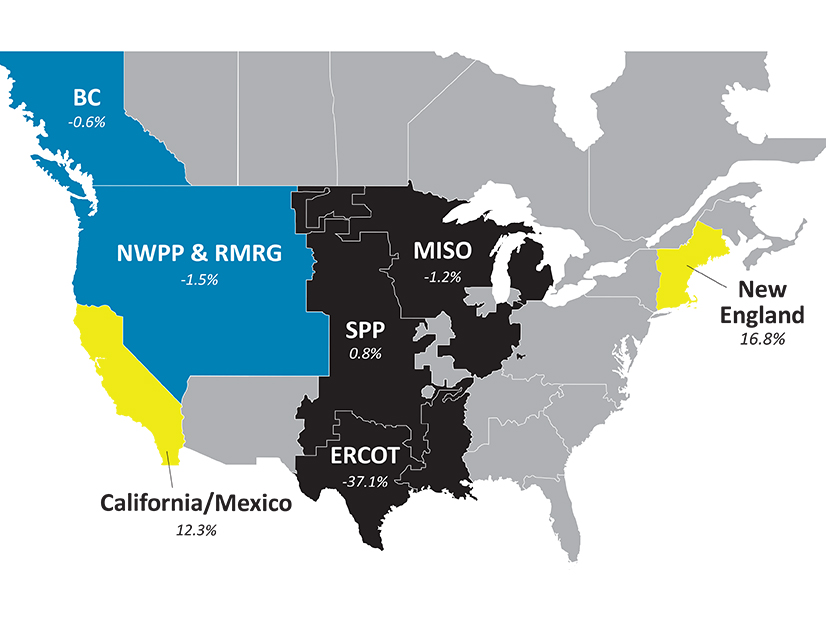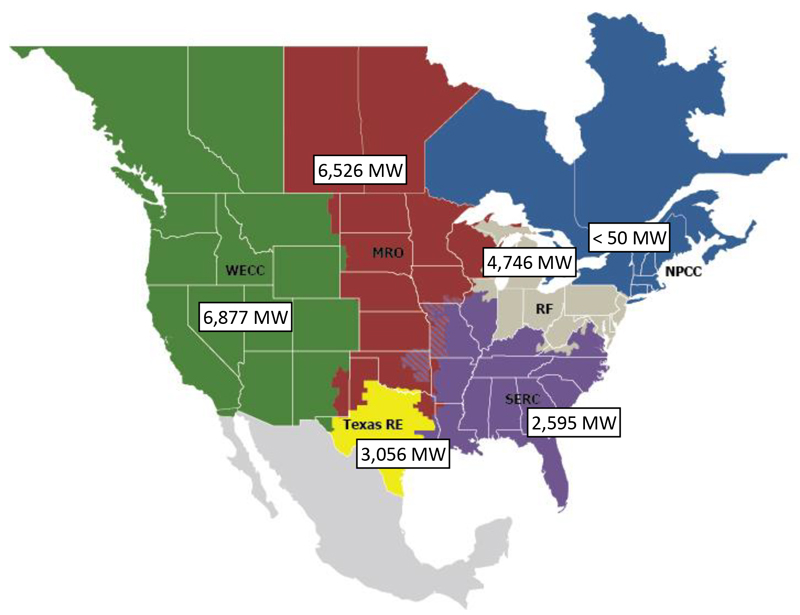
Extreme low temperatures remain a major threat to the Texas power grid in the upcoming winter months, according to NERC’s 2021-2022 Winter Reliability Assessment, while other regions face risks including natural gas supply disruptions and hydropower shortfalls.
February’s winter storms and the mass outages they caused across ERCOT, MISO and SPP are a natural focus in the report. John Moura, NERC’s director of reliability assessment and performance analysis, said the storms inspired an “innovative approach to our assessment [that] fundamentally changes the questions we’re answering as we perform our analysis.”
In a media call accompanying the release of the report on Thursday, Moura said that while all regions showed sufficient anticipated reserve margins — NERC’s traditional proxy for reliability — for the season, the events of February left the organization concerned that this metric was no longer adequate for a system increasingly comprising alternative types of generation like wind and solar power. Last year’s winter assessment showed adequate reserve margins but did not account for the failure of utilities in the south-central U.S. to prepare for unexpected extreme low temperatures. (See NERC Warns of Fuel Bottlenecks in Coming Cold Months.)
“Over the years, as the resource mix has changed, that measuring stick is not so useful anymore, because now we find that there’s not on-site fuel; that we can’t dispatch at will; that we have variable resources; that cold weather forces certain resources to come offline,” Moura said. He explained that for this assessment, NERC wanted to see how the grid might fare in the worst-case scenario, even if it is unlikely to happen.
“I think what we’ve done this year is say, ‘OK, instead of just looking at the things that happen most often, and [the] most likely thing to happen, let’s look at the tails, and let’s look at the worst things … that can happen and measure the resilience to them,’” he continued.
Severe Cold Dangers Persist in ERCOT
With February’s storms still fresh on everyone’s minds, NERC’s report identified severe cold weather as the most pressing concern in ERCOT, SPP and MISO.
For ERCOT, NERC warned that “resource derates for extreme conditions” similar to those seen in February could reach 28.1 GW, leading to a capacity deficit of up to 37.1%. This is despite the report finding that “operating plans for winter are in place,” based on responses to NERC’s Level 2 alert in August. (See NERC Issues Cold Weather Alert.) For MISO, conditions like those in February could cause a deficit of 1.2%, while SPP could see its reserve margin drop to 0.8%.
 Seasonal risk scenarios for MISO, SPP, and Texas RE-ERCOT | NERC
Seasonal risk scenarios for MISO, SPP, and Texas RE-ERCOT | NERCNERC said that generator owners and grid operators’ “responses to questions about winterization plans and fuel coordination indicate that some plant vulnerabilities can be anticipated” this winter.
In an email to ERO Insider, Texas Public Utility Commission spokesperson Michael Hoke noted that the first phase of the PUC’s new weatherization rule, set to take effect Dec. 1, “requires generators to implement the recommendations that came out of the 2011 winter outages and to address the specific equipment failures” from February’s storm. (See Texas Senators Call for New RRC Weatherization Rules.)
He added that many of the recommendations in FERC and NERC’s joint report on this year’s storm “mirror the steps we have already taken to make sure the grid is more resilient this winter.” (See FERC, NERC Release Final Texas Storm Report.)
Additional steps taken by the PUC include designating natural gas facilities that supply power plants as critical infrastructure in order to avoid the gas supply shortfalls that caused many outages in February. Participants in Thursday’s media call acknowledged these efforts and said the goal of the report was to draw attention to areas where additional work can benefit more consumers.
“Our message is, the operator needs to be prepared to implement the plans, but relentless preparation is in order,” said Mark Olson, NERC’s manager of reliability assessments. “And if we follow that plan, the outages rates can be improved, and the situation [may] not be as catastrophic as was experienced earlier this year.”
Gas, Coal Shortfalls Possible
Hazards faced by other regions include limited natural gas infrastructure (WECC-California/Mexico and NPCC-New England) and limited water for hydropower because of the Western drought (WECC outside of Alberta and the Southwest Reserve Sharing Group). The potential gas shortfalls in NPCC-New England are because the fuel is used for both heating and electric generation, creating the possibility of bottlenecks in the region, while those in WECC-CAMX are because of limited storage capability.

Global supply chain problems have also led to challenges in obtaining fuels; NERC noted that coal stocks in particular “have trended quickly downward in the last few months … after a buildup since last winter” and are at their lowest point in more than 10 years. While Olson said this level is “not an immediate concern for BPS reliability,” he said owners of fossil fuel-fired plants should monitor the situation closely because “late-state acquisitions this winter could be particularly challenging.”
NERC recommended several steps to reduce the risk of outages this winter:
- Grid operators, generator owners and generator operators (GOPs) should review NERC’s cold weather Level 2 alert and take recommended steps before winter arrives.
- Grid operators should prepare operating plans to manage potential supply shortfalls and take proactive steps for generator readiness, fuel availability and sustained operations in extreme conditions.
- Balancing authorities and reliability coordinators should conduct drills on alert protocols, while BAs and GOPs should verify protocols and operator training for communication and dispatch.
- Distribution providers and load-serving entities should review non-firm customer inventories and rolling blackout procedures to ensure that critical infrastructure loads such as gas and telecommunications are not affected.
Tom Kleckner contributed to this article.

